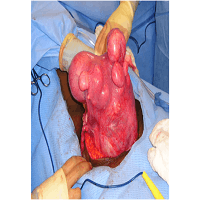OVERVIEW
- What are fibroid?
- Types, Causes of fibroid
- Risk Factors and Symptoms and Diagnosis of fibroid
- Treatment options
WHAT ARE FIBROID?
Fibroid are benign (non-cancerous) growths that can occur in your womb (uterus). They are also known as myomas or leiomyomas.
The vast majority of fibroid occur in women of reproductive age, and according to some estimates, they are diagnosed in black women two to three times more frequently than in white women. They are seldom seen in young women who have not begun menarche (menstruation) and they usually stabilize or regress in women who have passed menopause.
You may only have one fibroid or you might have many fibroids of different sizes. They don’t spread to other parts of your body, except in very rare circumstances.
TYPES OF FIBROID
Fibroid are named according to where they are found in your womb
- Subserosal Fibroid
Subserosal fibroid form on the outside of your uterus, which is called the serosa. They may grow large enough to make your womb appear bigger on one side. The subserous type rarely causes
any symptoms unless it is more than 5 cm.
- Intramural Fibroid: These types appear within the lining of the uterus (endometrium). Intramural fibroids may grow larger and actually stretch your womb. From our experience so far treating fibroids, this type of fibroid is the most common type of fibroid and are found in about 70 percent of women of childbearing age. The intramural type can cause heavy periods.
- Pedunculated Fibroids
When subserosal tumors develop a stem (a slender base that supports the tumor), they become pedunculated fibroids.
- Submucosal Fibroid
These types of tumors develop in the inner lining (myometrium) of your uterus. Submucosal tumors are not as common as other types, but when they do develop, they may cause heavy menstrual bleeding, irregular bleeding and trouble conceiving.
WHAT CAUSES FIBROID?
It is unclear why fibroids develop, but several factors may influence their formation.
- Hormones
Estrogen and progesterone are the hormones produced by the ovaries. They cause the uterine lining to regenerate during each menstrual cycle and may stimulate the growth of fibroids.
- Family History
Fibroids may run in the family. If your mother, sister, or grandmother has a history of this condition, you may develop it as well.
- Pregnancy
Pregnancy increases the production of estrogen and progesterone in your body. Fibroids may develop and grow rapidly while you are pregnant.
WHO IS AT RISK FOR FIBROID?
Women are at greater risk for developing fibroid if they have one or more of the following risk factors:
Pregnancy, a family history of fibroid, being over the age of 30, being of African descent, having a high body weight.
WHAT ARE THE SYMPTOMS OF FIBROID?
Most fibroid cause no symptoms at all. Your symptoms will depend on the location and size of the tumor(s) and how many tumors you have. Fibroid can become significantly problematic. If your tumor is very small, or if you are going through menopause, you may not have any symptoms.
Symptoms may include:
1-Heavy Bleeding during periods
2- Pelvic Pain
2- Increase menstrual cramping
3- Bladder pressure, frequent urination
4- Pain during intercourse,
5- Menstruation that lasts longer than usual
6- Pressure or fullness in your lower abdomen
7- Enlargement of the abdomen
8- Rectal pressure, constipation
9– Infertility or recurrent miscarriage
10- Pregnancy complications
11- Anemia
However, your prognosis will depend on the size and location of your fibroid. Fibroid may not need treatment if they are small or do not produce symptoms. If you are pregnant and have fibroid, or become pregnant and have fibroid, your physician will carefully monitor your condition. In most cases, fibroid do not cause problems during pregnancy if they are not in a threat location.
HOW ARE FIBROID DIAGNOSED?
You will need to see a gynecologist, who will do a pelvic exam. This exam is used to check the condition, size, and shape of your uterus. You may also need other tests:
- Ultrasound
An ultrasound uses high-frequency sound waves to produce images of your uterus on a screen. This will allow your doctor to see its internal structures and any fibroids present. A transvaginal ultrasound, in which the ultrasound wand (transducer) is inserted into the vagina, may provide clearer pictures since it is closer to the uterus during this procedure.
- Pelvic MRI
This in-depth imaging testing produces pictures of your uterus, ovaries, and other pelvic organs.
Fibroid Treatment (Category A)
THIS IS NATURAL CURE FOR FIBROIDS WITHOUT SURGERY
This is 100% natural medicine for fibroids treatment without negative side effect. Using Fibroids Solution Kit
Click here to read testimonies from our clients that have used the fibroids solution kit
Foods That Fight Fibroids & Endometriosis
Dangerous Foods that Worsen and Increase Fibroids on the Uterus
Fibroids Vs Pregnancy: 9 Questions about Uterine Fibroids every woman should know the answers
Natural solution to get rid of fibroids without surgery
OUR ADDRESS:
3rd Floor, 473, Lagos-Abeokuta Express Way, Old UBA Building Beside NNPC,, U-turn Bus Stop, Abule Egba, Lagos, Nigeria.
Mon – Friday (9.00 a.m. – 5.00 p.m.) Nigerian Time
Saturday (10.00 a.m. – 2.00 p.m.) Nigerian Time
Our Office is Close on Sunday but you can Whatsapp, Call, Email Us.
WHATSAPP: (+234)-8038690104
CALL: 08038690104 OR +234-8038690104
EMAIL: [email protected]
Website: www.iaswellnesscentre.ng
At I. A. & S. Wellness Centre, we have well trained staff members to guide you.
We are:
- Member National Association of Nigeria Traditional Medicine Practitioners (NANTMP),
- Member Association of Commonwealth Traditional Medicines Practitioners for West Africa
- We also have trained Acupunturists and TCM experts
OTHER TREATMENT WE OFFER:
The following are some of the treatments we offer Alphabetically (A-Z):
- Abdominal pain Natural treatment
- Abnormal Vaginal bleeding Natural treatment
- Acquired Immunodeficiency Syndrome(AIDS) natural treatment
- Adhesion natural treatment
- Amenorrhea Natural treatment
- Anemia natural treatment
- Arteriosclerosis and Atherosclerosis Natural treatment
- Appendicitis Natural treatment without surgery
- Asthma Natural treatment
- Candidiasis Natural treatment
- Cancer Natural treatment
- Cervical Polyps Natural treatment
- Cholesterol Natural treatment
- Chlamydia Infection Natural treatment
- Fibroids Natural Treatment (without surgery)
- Female Infertility Natural treatment
- Fibrocystic Breast Natural Treatment
- Male infertility Natural treatment
- Menopause Natural treatment
- Mouth odor and Cancer Natural treatment
PLEASE SHARE!

